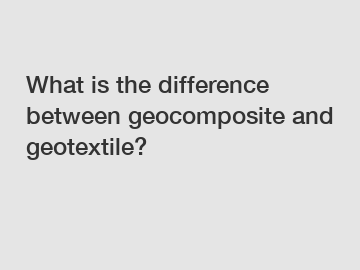Jan. 26, 2024
Construction & Real Estate
EcoGeoX Product Page
What is the difference between geocomposite and geotextile?
Geocomposites and geotextiles are both types of materials used in geotechnical engineering. While they may share some similarities, there are distinct differences between the two.

Firstly, geocomposites are composite materials made up of multiple layers, with each layer performing a specific function. These layers are typically made up of geotextiles, geogrids, or geomembranes. Geocomposites are designed to offer a combination of properties, such as filtration, drainage, reinforcement, and separation. They provide a more comprehensive solution compared to geotextiles alone.
On the other hand, geotextiles are single-layered permeable fabrics made from synthetic materials like polypropylene or polyester. They are primarily used to provide separation and filtration within soil, allowing water to pass through while preventing the migration of fine particles. Geotextiles are commonly used in applications such as road construction, erosion control, and drainage systems.
The distinction between geocomposites and geotextiles lies in their composition and functionality. Geotextiles are single-layered and serve specific purposes such as filtration and separation. Geocomposites, on the other hand, combine multiple layers with different functionalities to offer a comprehensive solution.
The development and use of geocomposites were driven by the need for more efficient and cost-effective geotechnical solutions. By combining various materials, geocomposites can address multiple engineering challenges simultaneously. For example, a geocomposite designed for a landfill application may consist of a filtration layer, a drainage layer, and a geomembrane to prevent leachate from contaminating the surrounding environment.
The functionality and performance of geocomposites make them particularly valuable in geotechnical applications where specific requirements need to be met. For instance, geocomposites have proven to be effective in erosion control, retaining wall reinforcement, and slope stabilization projects.
Furthermore, the utilization of geocomposites has improved the efficiency and sustainability of construction projects. By offering a single product with multiple functionalities, geocomposites reduce the need for using separate materials and installation steps. This simplification not only saves time and resources but also minimizes the overall environmental impact.
In conclusion, the main difference between geocomposites and geotextiles lies in their composition and functionality. Geocomposites consist of multiple layers, providing a combination of properties, while geotextiles are single-layered fabrics primarily used for separation and filtration. The development of geocomposites has provided engineers with more efficient and cost-effective solutions for various geotechnical challenges. Their versatility and performance have made them valuable components in erosion control, retaining wall reinforcement, and slope stabilization projects. Overall, the use of geocomposites has improved the efficiency and sustainability of construction projects.
You can find more information on our web, so please take a look.
If you want to learn more, please visit our website geotextile for iraq.
Previous: Exploring the Advantages of Polyester-Coated Aluminum
Next: Effortless Temperature Control: Discover the Game-Changing Thermostatic Bath Faucet!
If you are interested in sending in a Guest Blogger Submission,welcome to write for us!
All Comments ( 0 )